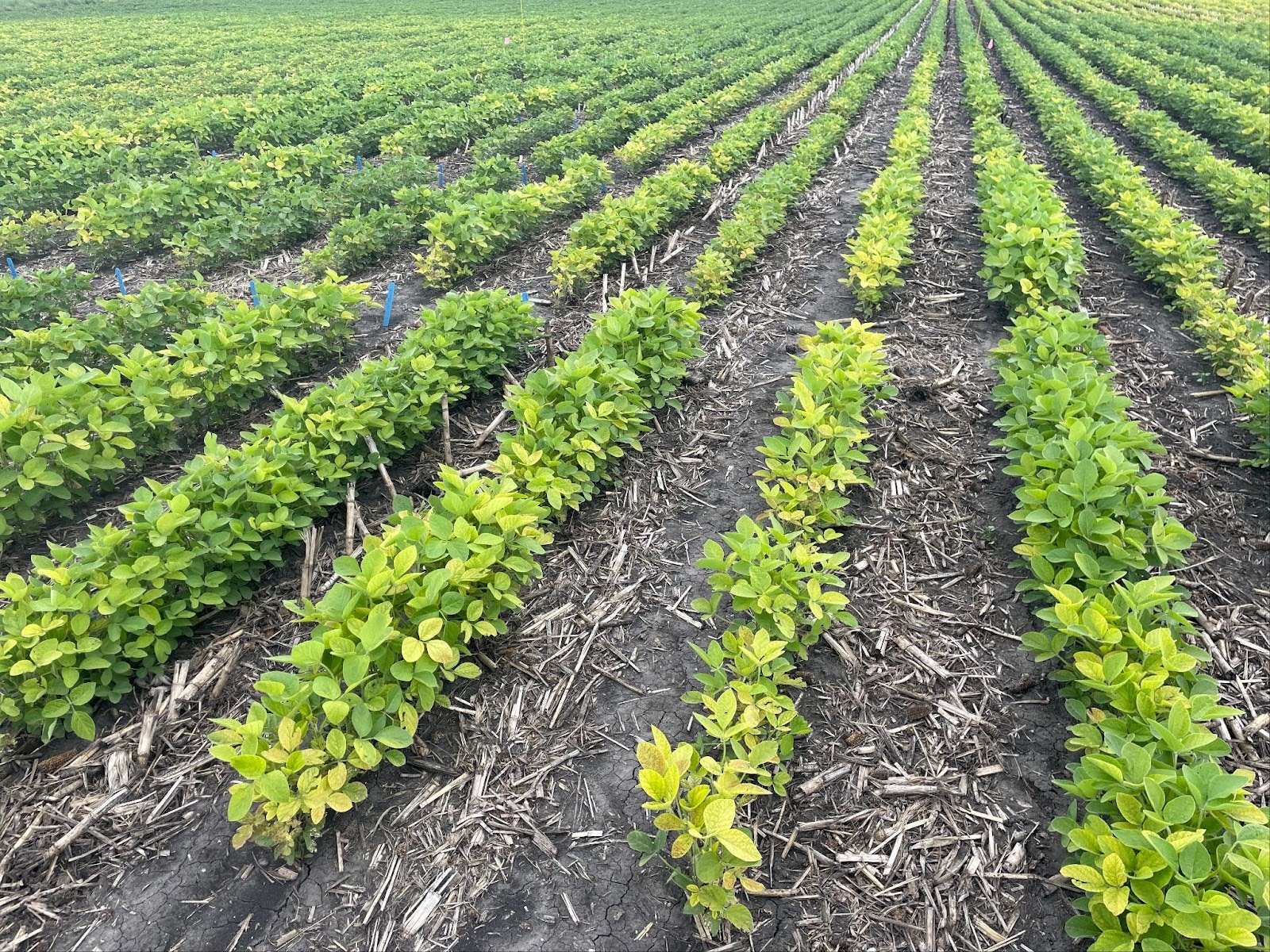IRON DEFICIENCY CHLOROSIS VARIETY RESPONSE TRIALS GIVE FARMERS MORE CONFIDENCE IN SOYBEAN SELECTION
When AgriGold agronomist Brian Ternus noticed that many of his customers struggled with managing IDC, he wanted to find a way to ground truth and localize the data they used to make decisions.
“Some farmers I work with weren’t seeing the results they were expecting from their seed choices, particularly in fields with a history of IDC,” he explains. “I realized there must be a better way to normalize the data to get a truer sense of IDC tolerances in my area. That’s how the IDC variety response trials started.”
Today, Ternus and fellow AgriGold agronomist Jake Gehrls screen AgriGold soybean varieties for IDC tolerance across trials in Minnesota. The goal is to generate location-specific data so farmers can confidently choose soybean varieties and more effectively manage IDC.
Key Takeaways:
- Iron deficiency chlorosis happens when a soybean plant can’t absorb iron from the soil.
- Using data from on-farm variety response trials, AgriGold agronomists rate various soybean varieties according to their IDC tolerance.
- Farmers can feel more confident in their variety selection when they have more information about those varieties’ risk of IDC.
Evaluating IDC Tolerance in Soybeans
Ternus and Gehrls plant replicated trials across three locations in Minnesota, evaluating all AgriGold soybean products in the 1.0 to 2.3 relative maturity range. They use soybean varieties with known high IDC tolerance as checks to compare the visual symptoms of test varieties. IDC symptoms typically appear in soybeans after the first trifoliate has formed, so visual evaluations start early.

Early leaf yellowing typical of IDC in soybeans.
“We check out plants around V3 and again around V6 or V7 to establish a baseline of the plants' appearance,” Gehrls explains. “We take photos at each evaluation to track IDC symptomology and progression. Toward the end of the season, around R1, we make a final evaluation to monitor how the different varieties recover throughout the season.”
Ratings across replications are averaged based on the level of yellow discoloration noted early in the season and how well the variety recovered from those symptoms over time.
“One of the more interesting things I've noticed is sometimes the varieties that look the worst on the initial rating actually recover better and end up being the better-looking plants later in the season,” Ternus says. “There seems to be a different recovery rate for every variety. Having the complete AgriGold soybean lineup for my geography out in the field in these trials gives me a better sense of those recovery rates. I can confidently tell farmers, ‘This one may not look good early in the season, but it will recover faster than some of the other varieties.’”

IDC variety response trial in Minnesota.
More Confident Seed Decisions
Gehrls and Ternus's data from the IDC variety response trials help them to recommend the varieties best-suited for fields with a history of IDC. This empowers farmers facing IDC challenges to be more confident in their seed decisions. In addition to the variety ratings, agronomists can share in-season photos to visually demonstrate the differences between soybean varieties with different response scores.
“Customers often ask me, ‘Is this IDC score right for this bean?’ and I can confidently say, ‘Yes, it's right on the money, or it's actually a little bit better, or maybe it's a little bit worse from what I've seen,’” Ternus says. “Being able to provide my customers ground-truthed research — using local and regional experience — gives them more peace of mind as they’re making one of the most important decisions of the season.”
Tips for Managing IDC in Soybeans
IDC occurs when a soybean plant can’t effectively absorb iron from the soil, even when adequate levels are present. The three primary causes of IDC in soybeans are soils containing:
- High calcium carbonate levels, which elevate soil pH
- High salt content
- High nitrate levels
Gehrls says wet conditions can cause IDC flare-ups in areas that are already susceptible, making poorly drained soils something to watch out for. Additionally, biotic and abiotic plant stress from herbicide injury, nematodes or plant diseases, for example, can also limit a crop’s ability to take up iron from the soil.
“The number one thing farmers can do to prevent IDC is proper variety selection,” Gehrls says. “That's why these IDC response trials are so important. We know that having the right variety in the field is the best defense against IDC.”
Beyond variety selection, Gehrls and Ternus offer these tips for managing IDC in susceptible fields:
- Consider using a chelated iron product like Soygreen® in-furrow to help with iron uptake
- Increase planting populations to boost the production of enzymes from soybean roots that help turn insoluble Fe(III) into more soluble Fe(II)
- Limit plant stress by avoiding compaction and protecting plant and root health
“There's a lot of information available about managing IDC in soybeans, but there’s no one-size-fits-all approach to management,” Ternus says. “Farmers may not have to employ every management practice mentioned to reduce IDC severity. I encourage growers to work with their trusted agronomist to develop a cost-effective strategy that includes IDC-tolerant varieties well-suited for their environment.”
For more information about managing IDC and soybean variety selection, contact your AgriGold representative.



